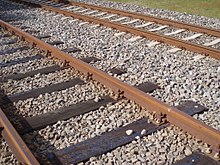
Back Шпала Byelorussian Шпалы BE-X-OLD Траверса Bulgarian Železniční pražec Czech Svelle Danish Schwelle (Bahn) German Στρωτήρες Greek Ŝpalo Esperanto Traviesa Spanish Liiper Estonian

A railroad tie, crosstie (American English), railway tie (Canadian English) or railway sleeper (Australian and British English) is a rectangular support for the rails in railroad tracks. Generally laid perpendicular to the rails, ties transfer loads to the track ballast and subgrade, hold the rails upright and keep them spaced to the correct gauge.
Railroad ties are traditionally made of wood, but prestressed concrete is now also widely used, especially in Europe and Asia. Steel ties are common on secondary lines in the UK;[1] plastic composite ties are also employed, although far less than wood or concrete. As of January 2008, the approximate market share in North America for traditional and wood ties was 91.5%, the remainder being concrete, steel, azobé (red ironwood) and plastic composite.[2]
Tie spacing may depend on the type of tie, traffic loads and other requirements, for example 2,640 concrete ties per mile on North American mainline railroads[3] to 2,112 timber ties per mile on LMS jointed track.[4]
Rails in the US may be fastened to the tie by a railroad spike; iron/steel baseplates screwed to the tie and secured to the rail by a proprietary fastening system such as a Vossloh or Pandrol which are commonly used in Europe.
- ^ "Steel Sleepers in the Rail Industry – they are still made, and have quite a history". Archived from the original on August 10, 2017. Retrieved August 9, 2017.
- ^ "M/W Budgets To Climb in 2008". Railway Track & Structures. 104 (1). New York, New York: Simmons-Boardman Publishing Company: 18–25. January 2008. ISSN 0033-9016. OCLC 1763403. Retrieved 23 December 2011.
- ^ Cite error: The named reference
RlyEng-101was invoked but never defined (see the help page). - ^ Cite error: The named reference
LMS-PW-Drawingswas invoked but never defined (see the help page).